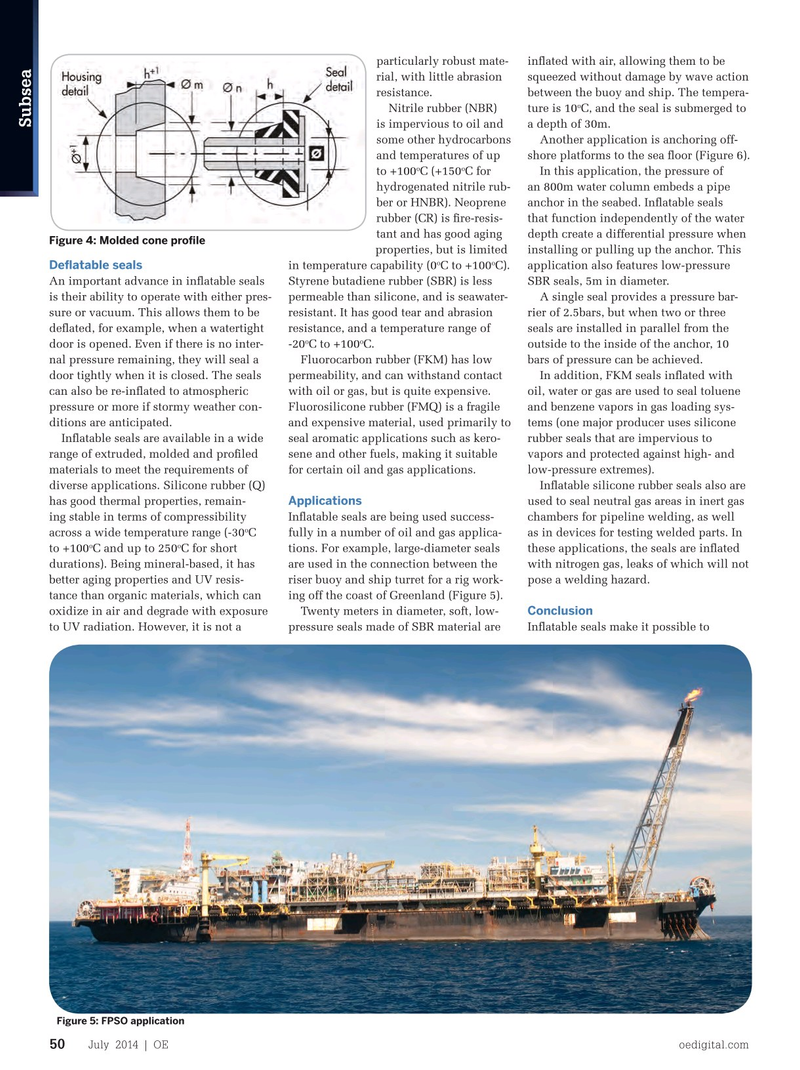
Page 48: of Offshore Engineer Magazine (Jul/Aug 2014)
Read this page in Pdf, Flash or Html5 edition of Jul/Aug 2014 Offshore Engineer Magazine
particularly robust mate- infated with air, allowing them to be rial, with little abrasion squeezed without damage by wave action resistance. between the buoy and ship. The tempera- o
Nitrile rubber (NBR) ture is 10 C, and the seal is submerged to
Subsea is impervious to oil and a depth of 30m. some other hydrocarbons Another application is anchoring off- and temperatures of up shore platforms to the sea foor (Figure 6).
o o to +100 C (+150 C for In this application, the pressure of hydrogenated nitrile rub- an 800m water column embeds a pipe ber or HNBR). Neoprene anchor in the seabed. Infatable seals rubber (CR) is fre-resis- that function independently of the water tant and has good aging depth create a differential pressure when
Figure 4: Molded cone profle properties, but is limited installing or pulling up the anchor. This o o
Defatable seals in temperature capability (0 C to +100 C). application also features low-pressure
An important advance in infatable seals Styrene butadiene rubber (SBR) is less SBR seals, 5m in diameter. is their ability to operate with either pres- permeable than silicone, and is seawater- A single seal provides a pressure bar- sure or vacuum. This allows them to be resistant. It has good tear and abrasion rier of 2.5bars, but when two or three defated, for example, when a watertight resistance, and a temperature range of seals are installed in parallel from the o o door is opened. Even if there is no inter- -20 C to +100 C. outside to the inside of the anchor, 10 nal pressure remaining, they will seal a Fluorocarbon rubber (FKM) has low bars of pressure can be achieved. door tightly when it is closed. The seals permeability, and can withstand contact In addition, FKM seals infated with can also be re-infated to atmospheric with oil or gas, but is quite expensive. oil, water or gas are used to seal toluene pressure or more if stormy weather con- Fluorosilicone rubber (FMQ) is a fragile and benzene vapors in gas loading sys- ditions are anticipated. and expensive material, used primarily to tems (one major producer uses silicone
Infatable seals are available in a wide seal aromatic applications such as kero- rubber seals that are impervious to range of extruded, molded and profled sene and other fuels, making it suitable vapors and protected against high- and materials to meet the requirements of for certain oil and gas applications. low-pressure extremes).
diverse applications. Silicone rubber (Q) Infatable silicone rubber seals also are
Applications has good thermal properties, remain- used to seal neutral gas areas in inert gas ing stable in terms of compressibility Infatable seals are being used success- chambers for pipeline welding, as well o across a wide temperature range (-30 C fully in a number of oil and gas applica- as in devices for testing welded parts. In o o to +100 C and up to 250 C for short tions. For example, large-diameter seals these applications, the seals are infated durations). Being mineral-based, it has are used in the connection between the with nitrogen gas, leaks of which will not better aging properties and UV resis- riser buoy and ship turret for a rig work- pose a welding hazard.
PROVIDING THE tance than organic materials, which can ing off the coast of Greenland (Figure 5).
Conclusion oxidize in air and degrade with exposure Twenty meters in diameter, soft, low-
VITAL CONNECTION to UV radiation. However, it is not a pressure seals made of SBR material are Infatable seals make it possible to
More HV power and control for reliable remote access to a global subsea industry that is stepping out and going deeper.
WWW.JDRGLOBAL.COM UNITED KINGDOM • UNITED STATES • THAILAND • SINGAPORE • MALAYSIA • GERMANY • BRASIL
Figure 5: FPSO application
July 2014 | OE oedigital.com 50 050_OE0714_Subsea_Inflatable seals.indd 50 6/20/14 6:44 PM

 47
47

 49
49